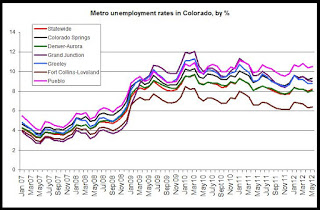Total employment growth in Colorado in May continued to show slight growth statewide in the year-over-year comparisons. In May, total employment
in Colorado was down 126,000 from the July 2008 peak. Employment trends
in various regions of the state differ, however, so this article looks
at which regions of the state have the highest unemployment rates, and
which regions have recovered the most in their labor markets.
Regional
employment trends can also provide us with some insights into local
housing demand since, all things being equal, those areas with the most
robust labor demand will also have the strongest demand for housing.
This would be reflected in apartment vacancy rates and in median home
price and home sales transactions, among other indicators.
The first graph compares unemployment rates in Colorado's metro areas.
The regional unemployment rates (not seasonally adjusted) for May 2012 are:
Colorado Springs, 9.3%
Denver-Aurora, 8.1%
Fort Collins-Loveland, 6.4%
Grand Junction, 9.0%
Greeley, 8.8%
Pueblo, 10.5%
Statewide, 8.2%
Since
mid-2009, The Fort Collins-Loveland area has consistently shown one of
the lowest unemployment rates while Grand Junction and Pueblo have
generally shown the highest rates. during recent months,however, the
unemployment rate in Grand Junction has fallen to the point where
Greeley, Grand Junction, and Colorado Springs now all have similar
unemployment rates near 9.0 percent.Colorado Springs now has the second-highest unemployment rate in the state at 9.3 percent.
Year over year,
the unemployment rate increased in Colorado Springs and
Pueblo and fell in all other metros. Total employment declined year over year in Colorado
Springs and Pueblo.
To provide some additional context, we can look
to see how far below total employment levels are below the most recent
peak in employment in each region. The peak time differs in each region.
For example, the labor market peaked in mid-2007 in the Colorado
Springs area, but it did not peak until late 2008 in the Grand Junction
area.
The following numbers reflect how far below the most recent peak are the May 2012 employment totals:
Colorado Springs MSA, 7.1%
Denver-Aurora MSA, 4.0%
Fort Collins-Loveland MSA, 2.2%
Grand Junction MSA, 9.4%
Greeley MSA 2.2%
Pueblo MSA, 2.6%
Statewide, 4.8%
All things being equal, the areas further below the peak have recovered the least from initial job losses.
By
far, Grand Junction remains the furthest below peak levels, with the
Colorado Springs area also dipping more than 7 percent below the peak. We
see here also that the Ft. Collins-Loveland area has one of the
strongest markets, with Greeley also moving toward peak levels.
(Note: If we
include the Boulder-Longmont MSA, we find that the Boulder area has
consistently been among the areas with the lowest unemployment rate. In May 2012, the rate in the Boulder-Longmont area was 6.2%, although unemployment was up,
year over year.)
